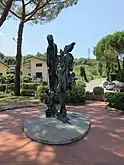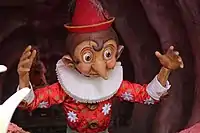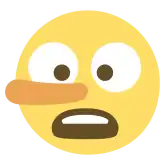Pinocchio
Pinocchio (/pɪˈnoʊkioʊ/ pih-NOH-kee-oh,[1] Italian: [piˈnɔkkjo]) is a fictional character and the protagonist of the children's novel The Adventures of Pinocchio (1883) by Italian writer Carlo Collodi of Florence, Tuscany.[2][3] Pinocchio was carved by a woodcarver named Geppetto in a Tuscan village. He was created as a wooden puppet but he dreams of becoming a real boy. He is notably characterized for his frequent tendency to lie, which causes his nose to grow.[4]
| Pinocchio | |
|---|---|
| The Adventures of Pinocchio character | |
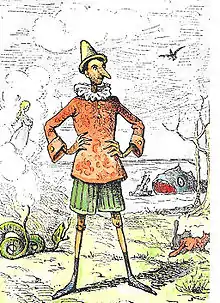 Original art by Enrico Mazzanti | |
| First appearance | The Adventures of Pinocchio (1883) |
| Created by | Carlo Collodi |
| In-universe information | |
| Species | Wooden marionette (later human) |
| Gender | Male |
| Family | Geppetto (father) |
| Nationality | Italian |
Pinocchio is a cultural icon. He is one of the most re-imagined characters in children's literature. His story has been adapted into many other media, notably the 1940 Disney film Pinocchio.[5] Collodi often used the Italian Tuscan dialect in his book. The name Pinocchio is a combination of the Italian words pino (pine), and occhio (eye); Pino is also an abbreviation of Giuseppino, the diminutive for Giuseppe (the Italian form of Joseph); one of the men who greatly influenced Collodi in his youth was Giuseppe Aiazzi, a prominent Italian manuscript specialist who supervised Collodi at the Libreria Piatti bookshop in Florence. Geppetto, the name of Pinocchio's creator and “father,” is the diminutive for Geppo, the Tuscan pronunciation of ceppo, meaning a log, stump, block, stock or stub.
Fictional character biography
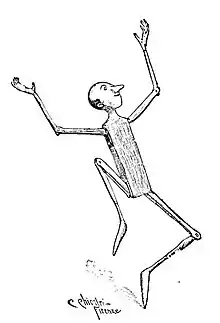
Pinocchio's characterization varies across interpretations, but several aspects are consistent across all adaptations: Pinocchio is a puppet, Pinocchio's maker is Geppetto and Pinocchio's nose grows when he lies.[6]
Pinocchio is known for having a short nose that becomes longer when he is under stress (chapter 3), especially while lying. In the original tale, Collodi describes him as a "rascal," "imp," "scapegrace" (mischievous or wayward person), "disgrace," "ragamuffin," and "confirmed rogue," with even his father, carpenter Geppetto, referring to him as a "wretched boy." Upon being born, Pinocchio immediately laughs derisively in his creator's face, whereupon he steals the old man's wig.
Pinocchio's bad behavior, rather than being charming or endearing, is meant to serve as a warning. Collodi originally intended the story, which was first published in 1881, to be a tragedy. It concluded with the puppet's execution. Pinocchio's enemies, the Fox and the Cat, bind his arms, pass a noose around his throat, and hang him from the branch of an oak tree.[7]
A tempestuous northerly wind began to blow and roar angrily, and it beat the poor puppet from side to side, making him swing violently, like the clatter of a bell ringing for a wedding. And the swinging gave him atrocious spasms...His breath failed him and he could say no more. He shut his eyes, opened his mouth, stretched his legs, gave a long shudder, and hung stiff and insensible.
Clothing and character
Pinocchio is a wooden marionette (a puppet that is manipulated with wires) and not a hand puppet (directly controlled from inside by the puppeteer's hand). However, the piece of wood from which he is derived is animated, and so Pinocchio moves independently. Basically good, he often gets carried away by bad company and is prone to lying. His nose will become longer and longer once he starts lying to others.[3] Because of these characteristics, he often finds himself in trouble. Pinocchio undergoes transformations during the novel: he promises The Fairy with Turquoise Hair to become a real boy, flees with Candlewick to the Land of Toys, becomes a donkey, joins a circus, and becomes a puppet again. In the last chapter, out of the mouth of The Terrible Dogfish with Geppetto, Pinocchio finally stops being a puppet and becomes a real boy (thanks to the intervention of the Fairy in a dream).
In the novel, Pinocchio is often depicted with a pointy hat, a jacket and a pair of colored, knee-length pants. In the Disney version, the appearance is different; the character is dressed in Tyrolean style, with Lederhosen and a hat with a feather.
Nose
Pinocchio's nose is his best-known characteristic. It grows in length when he tells a lie; this appears in chapter XVI. Collodi himself, in Note gaie claims how "to hide the truth of a speculum animae (mirror of the soul) face [ ... ] is added to the true nose another papier-mache nose." There is an inconsistency, however, because his nose grows when it is first carved by Geppetto, without Pinocchio ever lying.
The nose appears only a couple of times in the story, but it reveals the Blue Fairy's power over Pinocchio when he acts disobediently. After the boy's struggling and weeping over his deformed nose, the Blue Fairy summons woodpeckers to peck it back to normal.
Literary analysis
Some literary analysts have described Pinocchio as an epic hero. Like many Western literary heroes, such as Odysseus, Pinocchio descends into hell; he also experiences rebirth through metamorphosis, a common motif in fantasy literature.[8]
Before writing Pinocchio, Collodi wrote a number of didactic children's stories for the then-recently unified Italy, including a series about an unruly boy who undergoes humiliating experiences while traveling the country, titled Viaggio per l'Italia di Giannettino ('Little Johnny's voyage through Italy').[9] Throughout Pinocchio, Collodi chastises Pinocchio for his lack of moral fiber and his persistent rejection of responsibility and desire for fun.
The structure of the story of Pinocchio follows that of the folktales of peasants who venture out into the world but are naïvely unprepared for what they find, and get into ridiculous situations.[10] At the time of the writing of the book, this was a serious problem, arising partly from the industrialization of Italy, which led to a growing need for reliable labour in the cities; the problem was exacerbated by similar, more or less simultaneous, demands for labour in the industrialization of other countries. One major effect was the emigration of much of the Italian peasantry to cities and to foreign countries such as the United States.
The main imperatives demanded of Pinocchio are to work, be good, and study. And in the end Pinocchio's willingness to provide for his father and devote himself to these things transforms him into a real boy with modern comforts.[8]
Media portrayals
Literature
- Il Segreto di Pinocchio (1894) by Gemma Mongiardini-Rembadi, published in the United States in 1913 as Pinocchio under the Sea.
- Pinocchio in Africa (1903) by Eugenio Cherubini.
- The Heart of Pinocchio (1917) by Paolo Lorenzini.
- Pinocchio in America (1928) by Angelo Patri.
- Puppet Parade (1932) by Carol Della Chiesa.
- The children's novel The Golden Key, or the Adventures of Buratino (1936) is a free retelling of the story of Pinocchio by Russian writer Aleksey Nikolayevich Tolstoy. Some of the adventures are derived from Collodi, but many are either omitted or added. Pinocchio (Buratino) does not reform himself nor becomes a real human. For Tolstoy, Pinocchio as a puppet is a positive model of creative and non-conformist behavior.
- Hi! Ho! Pinocchio! (1940) by Josef Marino.
- Astro Boy (鉄腕アトム, Tetsuwan Atomu) (1952), a Japanese manga series written and illustrated by Osamu Tezuka, recasts loosely the Pinocchio theme.[11]
- Pinocchio in Venice (1991) by Robert Coover.
- Part 6 of Jojo's Bizarre Adventure (2000–2003) features an evil version of Pinocchio, brought to life by Bohemian Rhapsody.
- Marvel Fairy Tales (2006–2008), a comic book series by C. B. Cebulski, features a retelling of The Adventures of Pinocchio with the robotic superhero called The Vision in the role of Pinocchio.
- Wooden Bones (2012) by Scott William Carter describes a fictional untold story of Pinocchio, with a dark twist. Pino, as he's come to be known after he became a real boy, has discovered that he has the power to bring puppets to life himself.
- Pinocchio by Pinocchio (2013) by Michael Morpurgo.
- Pinocchio was the subject of the 2015 satirical novel Splintered: A Political Fairy Tale by Thomas London.
- The Wooden Prince (2017) and Lord of Monsters (2017) by John Claude Bemis adapt the story to a science fiction setting.
Early films
- Pinocchio first appeared in a cinematic adaptation in Pinocchio (1911), an Italian live-action silent film, directed by Giulio Antamoro. The character is performed by French-Italian comedian Ferdinand Guillaume.
- A 1936 adaptation The Adventures of Pinocchio (Le avventure di Pinocchio) was planned in Italy by Raoul Verdini and Umberto Spano, but it was never entirely completed and is now considered lost. Only the original script and a couple of still frames are all that survived of the film.
- The Golden Key (Zolotoy Klyuchik) is a 1939 Russian movie combining live action and stop-motion animation, directed by Aleksandr Ptushko. The story is based on the novel The Golden Key, or the Adventures of Buratino (1936) by Aleksey Nikolayevich Tolstoy. Pinocchio (Buratino) is a puppet, and voiced by actress Olga Shaganova-Obraztsova.
Disney version
| Pinocchio | |
|---|---|
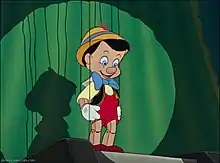 Pinocchio as seen in Walt Disney's Pinocchio | |
| First appearance | Pinocchio (1940) |
| Last appearance | Weirdmageddon 2: Escape from Reality (2015) |
| Created by | Carlo Collodi Walt Disney |
| Voiced by |
|
When Walt Disney Productions was developing the story for their film version of Pinocchio (1940), they intended to keep the obnoxious aspects of the original character, but Walt Disney himself felt that this made the character too unlikable, so alterations were made to incorporate traits of mischief and innocence to make Pinocchio more likable. Pinocchio was voiced by Dickie Jones. Today, the film is considered one of the finest Disney features ever made, and one of the greatest animated films of all time, with a rare 100% rating on the website Rotten Tomatoes. In the video game adaptation of the film, Pinocchio lives out (mostly) the same role as the film, traveling through the world filled with temptations and battling various forces.
This Disney incarnation was later used in Who Framed Roger Rabbit, voiced by Peter Westy; and Disney's House of Mouse, voiced by Michael Welch; as well as making cameo appearances in Aladdin, Teacher's Pet, Tangled, the Mickey Mouse television series, and Ralph Breaks the Internet.[14]
Pinocchio is a supporting character, voiced by Seth Adkins, in the Kingdom Hearts video game series. He plays a major role in the eponymous first game, Kingdom Hearts: Chain of Memories, and Kingdom Hearts 3D: Dream Drop Distance, while in Kingdom Hearts II he appears during a flashback at the early stages.
In Kinect Disneyland Adventures, he appears as a meet-and-greet character in Fantasyland and has several quests for the player. In Epic Mickey: Power of Illusion Pinocchio is featured as one of the many iconic Disney characters kidnapped by the evil witch Mizrabel in her plot to dominate their world; he is imprisoned alongside Genie in the Cave of Wonders until eventually being rescued by Mickey Mouse.
In the early 1990s, it is rumored that Elijah Wood portrayed the real-boy version of Pinocchio in the live-action segments for the updated Jiminy Cricket educational serials I'm No Fool and You, in addition to the new shorts of I'm No Fool.
20th-century
- The first child actor to portray Pinocchio was Alessandro Tommei in the 1947 Italian film The Adventures of Pinocchio (Le avventure di Pinocchio), directed by Gianetto Guardone.
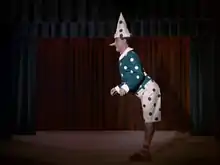
- Italian comedian Totò portrayed Pinocchio in the 1952 film Toto in Color (Totò a colori).
- Actor Mel Blanc voiced Pinocchio in a 1953 radio adaptation of the story. This is the second adaptation of Pinocchio with Mel Blanc involved, as Blanc voiced Gideon the Cat in the 1940 Disney film until all of his lines were deleted, save for three hiccups.
- The Adventures of Buratino (Priklyucheniya Buratino) is a 1959 Soviet animated feature film directed by Dmitriy Babichenko and Ivan Ivanov-Vano. The story is based on the novel The Golden Key, or the Adventures of Buratino (1936) by Aleksey Nikolayevich Tolstoy. Pinocchio (Buratino) is voiced by actress Nina Gulyaeva and in the 1998 shortened English-dubbed version (Pinocchio and the Golden Key), by child actor Joseph Mazzello.
- In Pinocchio (1965), the character is portrayed by actor John Joy.
- In the Belgian-American animated film Pinocchio in Outer Space (1965), the character is voiced by actor Peter Lazer.
- Pinocchio (Turlis Abenteuer) (1967) is an East German film, directed by Walter Beck. Pinocchio (Turli) is a puppet, voiced by actress Gina Presgott. In the final scene, as a boy, he is portrayed by Uwe Thielisch.

- The Adventures of Pinocchio (Un burattino di nome Pinocchio, 1972) is an Italian animated film, written and directed by Giuliano Cenci. Pinocchio is voiced by actress Roberta Paladini with Pamelyn Ferdin doing his English voice dub.
- Pinocchio and His Magic Show is a 1976 American movie. Pinocchio is a puppet, voiced by actress Ellen Prince.
- The Adventures of Buratino (Priklyucheniya Buratino) is a 1975 Soviet children's musical film directed by Leonid Nechayev. The story is based on the novel The Golden Key, or the Adventures of Buratino (1936) by Aleksey Nikolayevich Tolstoy. Pinocchio (Buratino) is portrayed by child actor Dmitri Iosifov.
- The 1977 animated film Spinnolio, created by John Weldon for the National Film Board of Canada, parodies Pinocchio with the story of a wooden boy who never comes to life, but nobody notices because his apparent skill at listening without talking makes him the ideal candidate for a job as manager of a department store's complaints desk.[15]
- Si Boneka Kayu, Pinokio (Pinocchio the wood puppet) is the 1979 Indonesian musical film, directed by Willy Willianto, written by Imam Tantowi and based on the original story with some additional adaptations. Pinocchio is portrayed by the Indonesian actor and comedian Ateng.
- Pinocchio appeared in the French-Dutch TV musical film Abbacadabra (1983), directed by Rien vam Wijk. He was portrayed by actor Nico Haak.
- Pinocho is a 1986 Argentinian movie, directed by Alejandro Malowichi. Pinocchio is portrayed by actress Soledad Silveyra.
- Pinocchio appeared in Filmation's 1987 epic animated film Pinocchio and the Emperor of the Night voiced by Scott Grimes.
- In the 1988 animation The Adventures of Pinocchio, directed by Ippei Kuri and Jim Terry, Pinocchio is voiced by actress Danielle Romeo.
- He appears in the 1991 animated film The Magic Riddle.
- Pinocchio appeared in the 1993 direct-to-video adaptation by GoodTimes Entertainment, voiced by Jeannie Elias.
- He appeared in the horror film Pinocchio's Revenge (1996) played by Verne Troyer and voiced by Dick Beals. He appears as a killer puppet.
- He was portrayed by Jonathan Taylor Thomas in the film The Adventures of Pinocchio (1996). Thomas also voiced the title character's puppet form. In the 1999 sequel The New Adventures of Pinocchio, Pinocchio was played by Gabriel Thomson (who also voiced his puppet form).
- He was portrayed by actor Carmelo Bene in the Italian TV movie Pinocchio ovvero lo spettacolo della provvidenza (1999).
21st-century
- Child actor Seth Adkins portrayed Pinocchio in the television musical film Geppetto (2000).
- Pinocchio appears as a supporting character in the animated films Shrek (2001), Shrek 2 (2004), Shrek the Third (2007), and Shrek Forever After (2010), voiced by Cody Cameron. He was also featured in other animated shorts and videos of the same series: Shrek in the Swamp Karaoke Dance Party (2001), Shrek 4-D (2003), Far Far Away Idol (2004), Shrek the Halls (2007), Scared Shrekless (2010), Donkey's Christmas Shrektacular (2010), and Thriller Night (2013).
- Actor Roberto Benigni portrayed Pinocchio in the 2002 Italian movie Pinocchio, while the English dub voice was provided by Breckin Meyer.
- Pinocchio 3000 is a 2004 Canadian-French-Spanish computer-animated film, directed by Daniel Robichaud. Pinoccho, a robot that was built by Geppetto, is voiced by Canadian actress Sonja Ball in English.[16]
- In the 2012 Italian animated adaptation Pinocchio, directed by Enzo D'Alò, Pinocchio is voiced by child actor Gabriele Caprio in the Italian original version. In the English dub he is voiced by child actor Robert Naylor in the Canadian release, and by singer Johnny Orlando in the American one.
- Child actor Federico Ielapi portrayed Pinocchio in the live-action Italian film Pinocchio (2019), co-written, directed and co-produced by Matteo Garrone. Prosthetic makeup was used to turn Ielapi into a puppet. Ielapi also dubbed himself in the English-language version of the movie.
- In 2020, Netflix announced its cast selection for a stop-motion musical film titled Pinocchio, inspired by Gris Grimly’s original design for Pinocchio, and co-directed by Guillermo del Toro and Mark Gustafson for a 2021 release. The announcement included Gregory Mann as the title role, Ewan McGregor as Cricket, and David Bradley playing Geppetto.[17][18][19]
Television
- Musician and comedian Spike Jones portrayed Pinocchio in the first television adaptation, a satirical version aired 24 April 1954 as an episode of The Spike Jones Show.
- Pinocchio was portrayed by thirteen-year-old Andrew Irvine as 'Nokie'[20] in the 1955 ITV children's series Round at the Redways.
- Mickey Rooney was Pinocchio in the television musical adaptation Pinocchio (1957), directed by Paul Bogart, aired 13 October 1957.
- In the 1959 Italian television series The Adventures of Pinocchio (Le avventure di Pinocchio), directed by Enrico D'Alessandro and Cesare Emilio Gaslini, Pinocchio is portrayed by Carlo Chamby.
- The New Adventures of Pinocchio (1960–61) is an American animated television series. Pinocchio is voiced by actress Joan Fowler.
- De avonturen van Pinokkio (1968–69) is a Dutch TV miniseries. Pinocchio is portrayed by actress Wieteke van Dort.
- Tatsunoko Productions created a 52-episode anime series entitled Pinocchio: The Series, first aired in 1972. This series has a distinctly darker, more sadistic theme, and portrays the main character Pinocchio (Mokku) as suffering from constant physical and psychological abuse and freak accidents. Pinocchio was voiced by actress Yuko Maruyama and in the 1992 English-dubbed version by actor Thor Bishopric.
 Pinocchio and Geppetto in Pinocchio: The Series
Pinocchio and Geppetto in Pinocchio: The Series - Pinocchio (1968) is an American musical TV film, directed by Sid Smith. It was aired 8 December 1968 in the series Hallmark Hall of Fame. Pinocchio is portrayed by actor Peter Noone.
- The Adventures of Pinocchio (Le avventure di Pinocchio, 1972) is an Italian television miniseries, co-written and directed by Luigi Comencini. Pinocchio was portrayed by child actor Andrea Balestri.
- In 1973, Piccolo, a kaiju based on Pinocchio, appeared in episode 46 of Ultraman Taro.
- Another anime series starring Pinocchio, entitled Piccolino no Bōken, was produced by Nippon Animation in 1976.
- Pinocchio is a 1976 American television musical film, directed by Ron Field and Sid Smith, aired 27 March 1976. Pinocchio is portrayed by actress Sandy Duncan.
- In 1976, Pinocchio appeared in a News Flash segment on Sesame Street, performed by Frank Oz.
- Pinocchio is a 1978 American television miniseries in 4 episodes, directed by Barry Letts. Pinocchio is a puppet voiced by actress Rosemary Miller. In the final scene he is portrayed by child actor Joshua White.
- In 1980, Pinocchio appeared in the "Señor Wences" episode of The Muppet Show, performed by Steve Whitmire. His puppet was built by Bob Payne.
- In the 1980 animation Pinocchio's Christmas, directed by Jules Bass and Arthur Rankin Jr., Pinocchio is voiced by child actor Todd Porter.
- Pinocchio (1984) is an episode of the American television series Faerie Tale Theatre, directed by Peter Medak. Pinocchio is portrayed by actor Paul Reubens.
- In the early 1990s, it is rumored that Elijah Wood portrayed the real-boy version of Pinocchio in the live-action segments for the updated Jiminy Cricket educational serials I'm No Fool and You, in addition to the new shorts of I'm No Fool.
- Pinocchio was featured in a 1997 episode of the animated series Happily Ever After: Fairy Tales for Every Child, voiced by actor Will Smith.
- Child actor Seth Adkins portrayed Pinocchio in the television musical film Geppetto (2000) and as a guest star, in an episode of The Drew Carey Show, aired 1 March 2000. He also voiced the character in the video game Kingdom Hearts (2002).
- Child actor Robbie Kay was Pinocchio in the two-episode TV film Pinocchio (2008), directed by Alberto Sironi.
- Pinocchio appeared in 2010 in the animated television series Simsala Grimm in an episode of the same name.
- Pinocchio is a recurring character in the television series Once Upon a Time (2011–16). He appears in Storybrooke in the form of a mysterious man named August Booth (played by Eion Bailey). In the Enchanted Forest, his younger self is played by Jakob Davies, but he was released into our world before the curse by Geppetto; Geppetto had been charged with making a magic cabinet in order to allow Snow White and series protagonist Emma Swan to escape the curse, but Geppetto arranged for Pinocchio to enter the cabinet instead as he feared that his son would cease to exist if the curse was cast as there would have been no way for him to be born without magic. August begins to return to his wooden state towards the end of the first season due to his selfishness, but following his near death by Tamara, the Blue Fairy restored Pinocchio to his child self for his compassion and courage and he resumes living with Geppetto. In the fourth season, he was restored to his adult state by Rumplestiltskin so that he could torture him for information about the Author. In the sixth season, it was revealed that August was the one who inspired Emma to take on the surname Swan after he shared with her the fairy tale The Ugly Duckling when they were kids.
- Pinocchio appeared as a villain in two episodes of The Grim Adventures of Billy & Mandy (2004 & 2006), voiced by Scott Menville. He desires to become a real boy but by eating a real boy's flesh.
- Actor Sigurður Þór Óskarsson portrayed Pinocchio in an episode (New Kid in Town) of the TV series LazyTown, aired 5 October 2014.
- Pinocchio, a 2014–2015 South Korean television series starring Lee Jong-suk and Park Shin-hye.
- Rooster Teeth's web series RWBY features a character named Penny Polendina, who alludes to Pinocchio.
Stage production
- "Pinocchio" (1961-1999), by Carmelo Bene.
- "Pinocchio" (2002), musical by Saverio Marconi and musics by Pooh.
- The Adventures of Pinocchio is a 2007 opera in two acts by English composer Jonathan Dove with a libretto by Alasdair Middleton. The original production opened at the Grand Theatre, Leeds on 21 December 2007 with mezzo-soprano Victoria Simmonds as Pinocchio.
- Actor John Tartaglia portrayed Pinocchio in the original Broadway cast of Shrek the Musical (2008) as well as in the 2013 filmed version.
- L'altro Pinocchio (2011), musical by Vito Costantini based on L'altro Pinocchio (Editrice La Scuola, Brescia 1999).
- Pinocchio. Storia di un burattino da Carlo Collodi by Massimiliano Finazzer Flory (2012)
- The Adventures of Pinocchio is a 2009 opera by Israeli composer Jonathan Dove, "for 3 actors, flute, oboe, clarinet, horn, bassoon and piano".
- The musical Pinocchio - Superstar was produced by Norberto Bertassi and performed by young talents association Teatro. Premiered on 20 July 2016 in Mödling, Austria.
- Pinocchio (2017), musical by Dennis Kelly, with songs from 1940 Disney movie, directed by John Tiffany, premiered on the National Theatre, London.
In popular culture
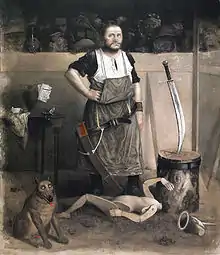
- The story is set in a villa in Collodi, where Carlo Collodi had spent his youth, in 1826. This villa is now named Villa Pinocchio.[21]
- In the series of paintings titled La morte di Pinocchio, Italian painter and engraver Walther Jervolino (1944–2012) shows Pinocchio being executed with arrows or decapitated, thus presenting an alternative story ending.
- 12927 Pinocchio, a main-belt asteroid discovered on 30 September 1999, by M. Tombelli and L. Tesi at San Marcello Pistoiese, was named after Pinocchio.
- In A.I. Artificial Intelligence (2001), the story of Pinocchio is woven throughout the story as a robot, an artificial boy, struggles to become real through a search for the Blue Fairy.[22]
- In the modern Battlestar Galactica series, the producers have stated that main antagonist John Cavil basically suffers from an inverted version of Pinocchio Syndrome; where Pinocchio was a puppet who wanted to be a real boy, Cavil was a machine who was given a human body and now wants to be a true machine, resenting his creators for making him in the image of humanity.
- In Avengers: Age of Ultron (2015), the story of Pinocchio is referenced to symbolize the cybernetic villain Ultron becoming free of his master (Tony Stark's) orders. A dark version of the Disney Pinocchio song "I've Got No Strings" is also quoted by him, and used in promotional material for the film.[23]
- In 2015 and 2016, the Dutch themepark Efteling used its own version of Pinocchio's story for a musical in her theater. It is a mix of the original Carlo Collodi's story, the Disney version and some adjustments. Fay de Fee (translated: Fay the Fairy) here takes on the role of the good fairy, but is also Pinocchio's 'conscience'. In the Efteling version there is also a Monster Fish that eats Pinocchio and Geppetto. Various other versions speak of a Whale. Halfway through 2016, the fairytale of Pinocchio was added in the Fairytale Forest of the Efteling. A walk-through attraction in a wooded area, in which various scenes from fairytales are depicted. Especially for the Italian visitors, an Italian translation was added for this fairytale.[24][25]
- Unicode emoji list since version 9.0 (2016) includes character U+1F925 🤥 LYING FACE with description "face, lie, lying face, Pinocchio".[26]
References
- "pinocchio noun - Definition, pictures, pronunciation and usage notes". Oxford Advanced Learner's Dictionary. 16 October 2014. Retrieved 2 August 2019.
- Joy Lo Dico (2 May 2009). "Classics corner: Pinocchio by Carlo Collodi". Culture. The Guardian. London. Retrieved 1 October 2015.
- Martin, Clancy (6 February 2015). "What the Original 'Pinocchio' Really Says About Lying". The New Yorker. Retrieved 1 October 2015.
- Reardon, Sara (7 June 2013). "Carlo Collodi's Pinocchio: Why is the original Pinocchio subjected to such sadistic treatment?". Slate. Retrieved 17 June 2013.
- "Pinocchio: Carlo Collodi - Children's Literature Review". Encyclopedia.com. Retrieved 1 October 2015.
- Linda Falcone (2007). Italian, It's All Greek to Me: Everything You Don't Know About Italian ... ISBN 9781571431714. Retrieved 17 June 2013.
- Rich, Nathaniel (24 October 2011). "Carlo Collodi's Pinocchio: Why is the original Pinocchio subjected to such sadistic treatment?". Slate.com. Retrieved 1 October 2015.
- Morrissey, Thomas J., and Richard Wunderlich. "Death and Rebirth in Pinocchio." Children's Literature 11 (1983): 64–75.
- Gaetana Marrone; Paolo Puppa (26 December 2006). Encyclopedia of Italian Literary Studies. Routledge. pp. 485–. ISBN 978-1-135-45530-9.
- Collodi, Carlo (1996). "Introduction". In Zipes, Jack (ed.). Pinocchio. Penguin Books. pp. xiii–xv.
- Schodt, Frederik L. "Introduction." Astro Boy Volume 1 (Comic by Osamu Tezuka). Dark Horse Comics and Studio Proteus. Page 3 of 3 (The introduction section has 3 pages). ISBN 1-56971-676-5.
- "June Foray as Walt Disney's "Pinocchio & "Ferdinand the Bull"". cartoonresearch.com. Retrieved 9 September 2020.
- "Hudson Hornet". Behind The Voice Actors. Retrieved 9 September 2020.
- "Video Interview with TANGLED Directors Nathan Greno and Byron Howard". Collider. 21 November 2010. Retrieved 2 March 2015.
- "Canadian animation recommended—for Canadians". Baltimore Sun, 28 January 1983.
- Ten of the Most Translated Books Across the Globe Archived 29 April 2020 at the Wayback Machine on Ten of the Most Translated Books Across the Globe: "A look at 10 of the most translated books of all time, including The Holy Bible and several fiction books." (29 April 2020)
- Trumbore, Dave (6 November 2018). "Netflix Sets Guillermo del Toro's 'Pinocchio' and Henry Selick's 'Wendell & Wild' for 2021". Collider. Retrieved 6 November 2018.
- D'Alessandro, Anthony (19 August 2020). "Cate Blanchett, Ewan McGregor, Tilda Swinton & More Round Out Cast For Guillermo del Toro Netflix 'Pinocchio' Movie". Deadline. Retrieved 21 August 2020.
- "Netflix announces cast for 'Pinocchio' animated musical film". ABC News. Retrieved 20 August 2020.
- "Andy Ivine: Bio, Chapter 1". Andyirvine.com. 14 October 2012. Archived from the original on 23 September 2015. Retrieved 1 October 2015.
- "Pinocchio's Luxury Villa For Sale In Tuscany". Lionard. Retrieved 1 October 2015.
- West, Rebecca (2002). "The Persistent Puppet: Pinocchio's Heirs in Contemporary Fiction and Film". University of Chicago. Retrieved 6 July 2016.
- McMillan, Graeme (22 October 2014). "What's Revealed in the Leaked 'Avengers: Age of Ultron' Trailer?". Hollywood Reporter. Retrieved 6 July 2016.
- "Pinokkio Sprookjesbos - Efteling". efteling.com (in Dutch). Retrieved 2 September 2020.
- Pinocchio Efteling Version
- "Emoji List, v11.0". www.unicode.org. Retrieved 24 October 2018.
External links
| Library resources about Pinocchio |

